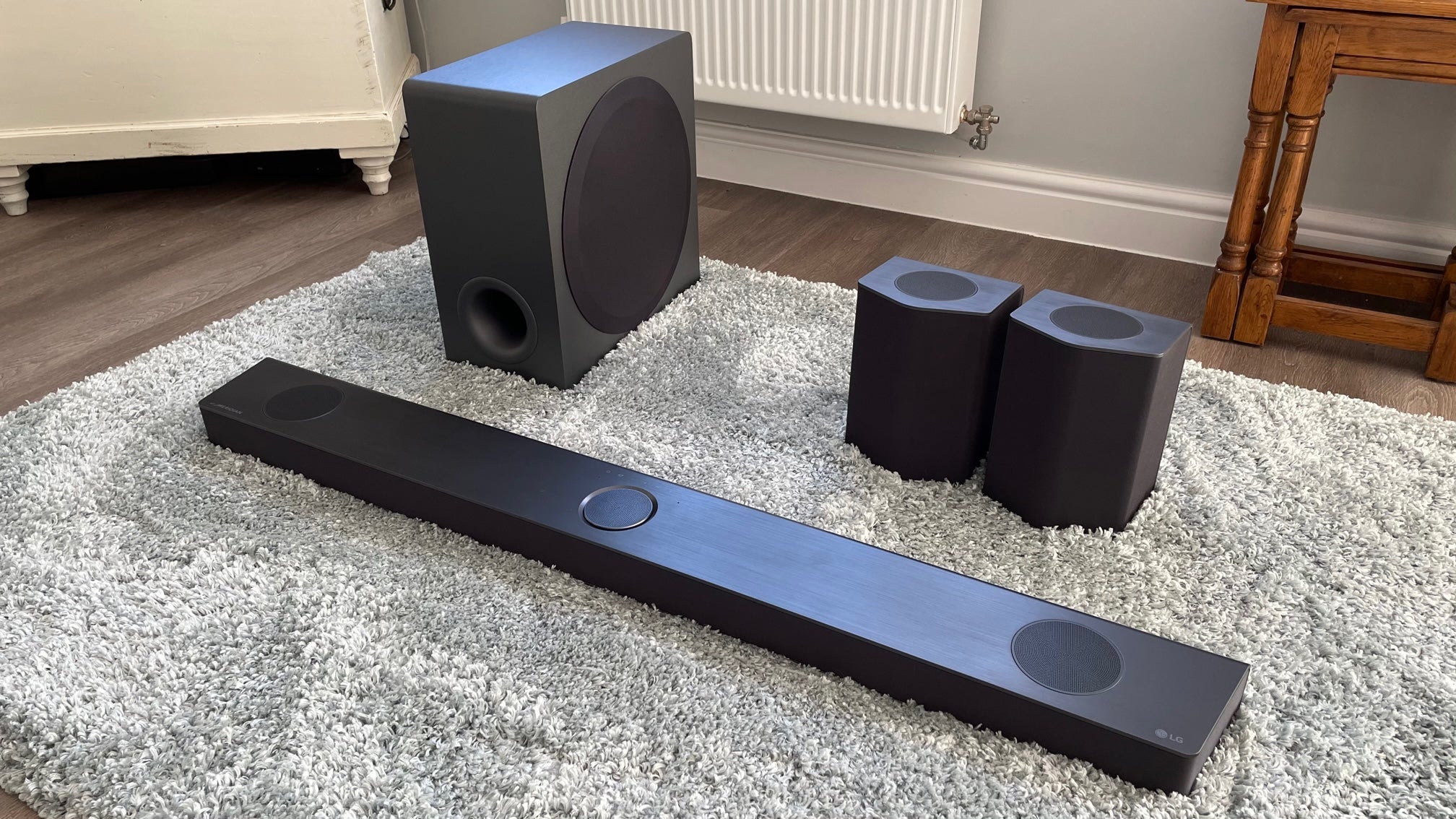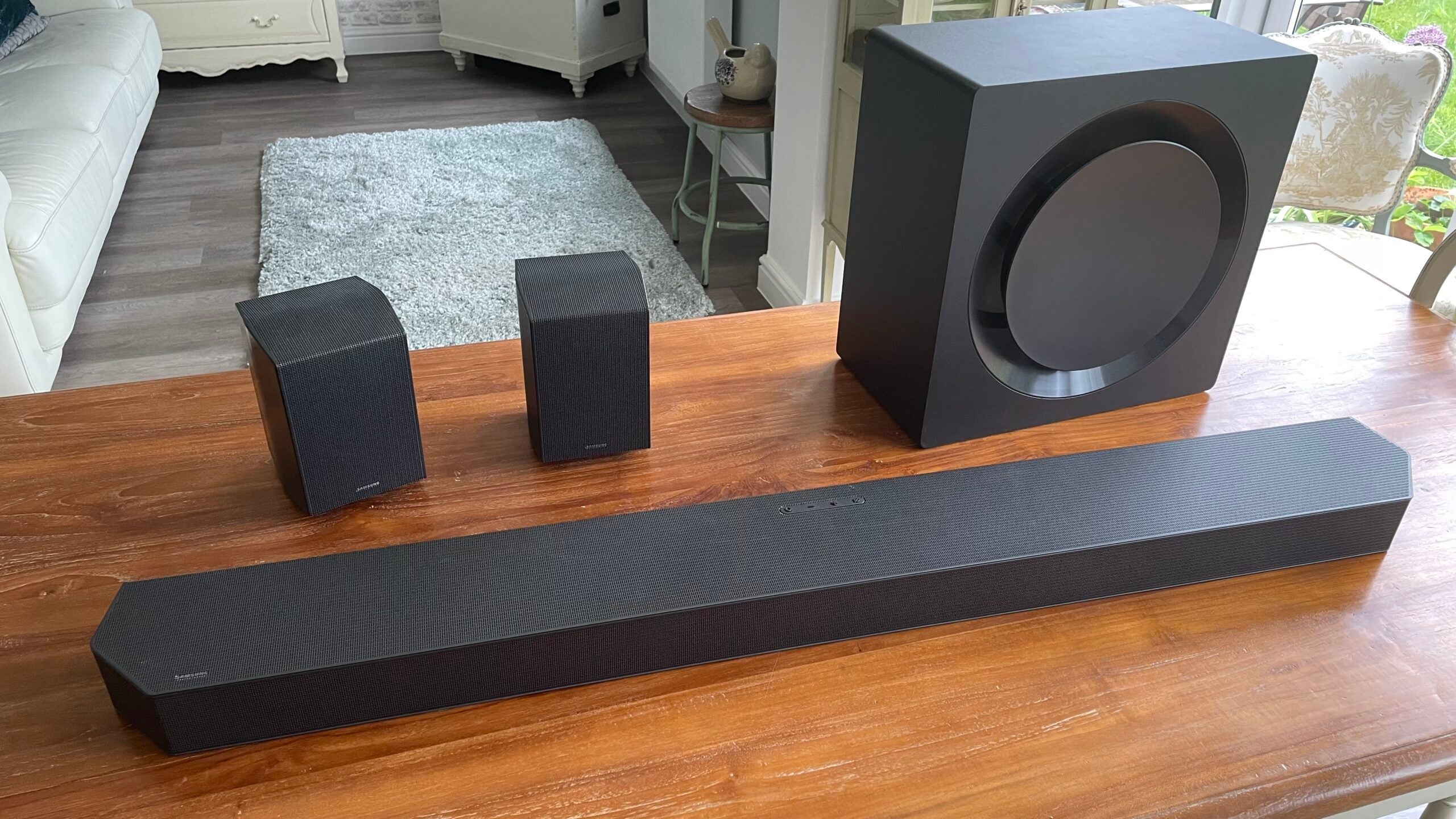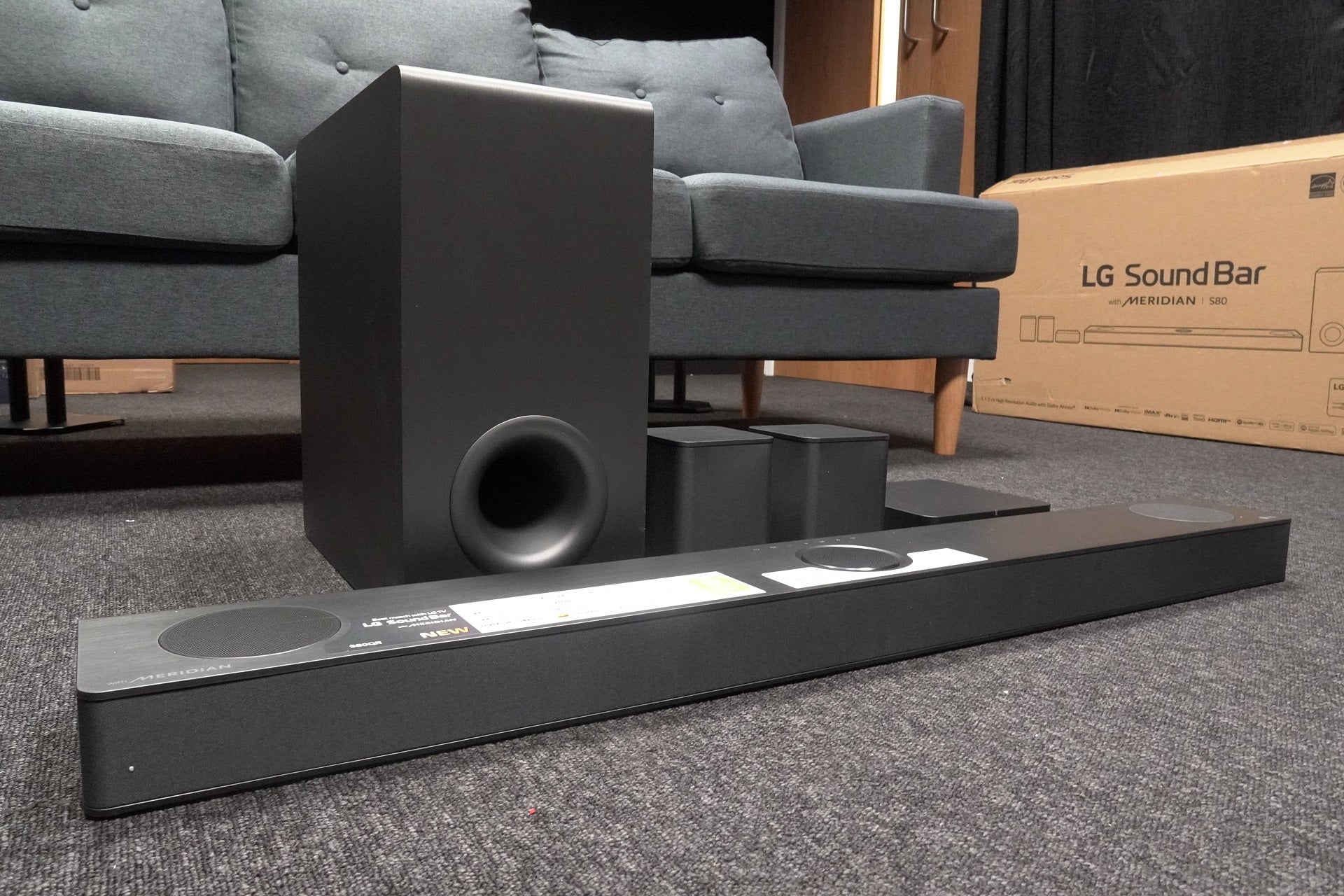Sony TA-AN1000 Review
An engaging mid-range 7.1-channel AV amplifier





Verdict
The Sony TA-AN1000 is a fun 7.1-channel AV amplifier that delivers entertaining object-based audio and extensive gaming features. Sony’s 360 Spatial Sound Mapping tech is useful if speaker placement is compromised, but the build is a bit lightweight, more power would be nice, and it’s not very musical, so this amp may struggle against the competition.
Pros
- Fun and engaging multichannel audio
- Virtual speakers could prove useful
- Well specified set of features
Cons
- Not the most musical of receivers
- Limited to 7.1 channels
- Build could be better
Key Features
- Object-based audioDecoding for Dolby Atmos, DTS:X and IMAX Enhanced up to 7.1 channels
- Built-in amplificationSeven channels of Class D with a claimed 120W into 6ohms
- 360 Spatial Sound MappingUsing positional information, measurements and proprietary processing, multiple phantom speakers are generated for a more immersive audio experience
- Gaming featuresSupport for 4K/120p, ALLM, and VRR, plus Auto HDR Tone Mapping and Auto Genre Picture Mode with PlayStation 5
- Network featuresChromecast built-in, supports AirPlay 2 and Spotify Connect, works with Sonos, and Roon tested
Introduction
The Sony TA-AN1000 is the brand’s latest AV amplifier for 2023, replacing the capable and popular STR-DN1080 at the top of its current line-up. It sports seven channels of built-in Class D amplification, plus processing for up to 7.1 channels with support for all the main object-based audio formats, including Dolby Atmos, DTS:X and IMAX Enhanced.
The big new feature is Sony’s 360 Spatial Sound Mapping, which applies proprietary processing to shift the position of physical speakers in virtual space, creating a more immersive soundstage that isn’t limited by the actual sonic environment. This clever acoustic wizardry can prove very useful when you’re forced to compromise on speaker placement.
The TA-AN1000 is very well-specified with HDMI 2.1 connections that can handle 8K/60p and 4K/120p, plus a host of gaming-related features. It also supports high-resolution audio, and Sony offers optional wireless rears and subwoofers for anyone adverse to speaker cables. But despite all these features, this capable AV amplifier won’t break the bank.
Design
- Finished in matte black
- Dimensions: 430 x 156 x 331mm
- Weight: 10.3kg
The Sony TA-AN1000 looks very similar to the earlier STR-DN1080, and to be honest it’s not going to win any beauty pageants. The front facia is minimalist at best, with input and volume dials on the right hand side, along with a small LED display towards the centre. There’s also a row of push buttons for access to various features such as the Movie, Music, and 360 Spatial Sound modes.
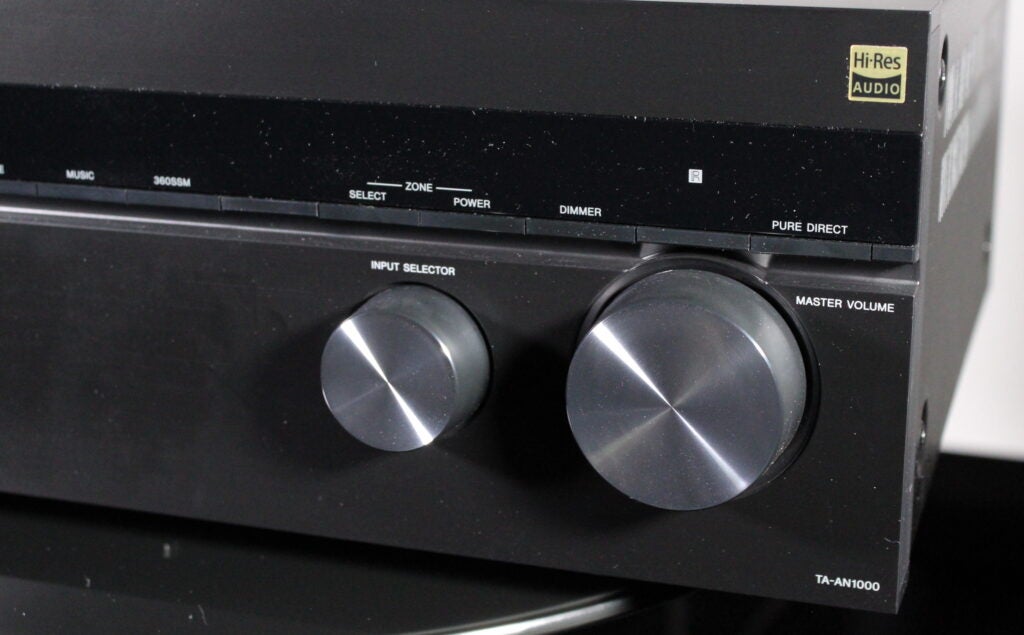
The TA-AN1000 uses a simple matte black finish, which adds to its generally spartan appearance. The build quality is also rather disappointing considering this AV amplifier’s price point, with the chassis feeling somewhat fragile, while the buttons on the front are decidedly plasticky. On the plus side, at only 10.3kg in weight you’re unlikely to injure yourself while installing this particular amp.
Connectivity and Control
- HDMI 2.1 with support for 8K/60p and 4K/120p
- Chromecast and AirPlay 2 built-in
- Small but clearly-labelled remote
The Sony TA-AN1000 sports minimal connections at the front, with only a USB port, a headphone jack, and a socket for the calibration microphone. This theme of simplicity also extends to the rear, where you’ll find an equally stripped-down selection of inputs and outputs.

There are a number of analogue inputs, and even composite video inputs/output, which you don’t often see these days, but surprisingly there’s only one coaxial digital input and one optical digital input. There’s also an Ethernet port, IR in and out, analogue outputs to a third zone, dual subwoofer outputs, and speaker terminals for the built-in amplification.
Thankfully there are six HDMI inputs, two of which are HDMI 2.1 with support for 8K/60p and 4K/120p. There are also two HDMI 2.1 outputs: a main output with eARC (Enhanced Audio Return Channel), and one for a second zone.
The HDMI 2.1 ports support gaming features such as VRR (Variable Refresh Rate) and ALLM (Auto Low Latency Mode), along with Auto HDR Tone Mapping and Auto Genre Picture Mode for use with a PlayStation 5 and compatible Sony TV. In addition, all HDMI connections support HDR10, HLG (Hybrid Log-Gamma) and Dolby Vision.
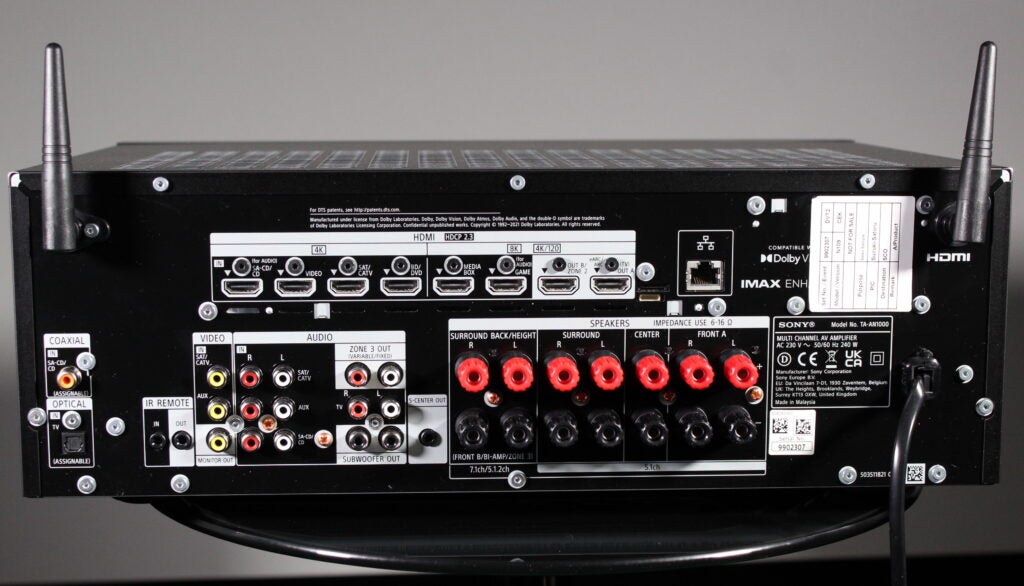
There’s also a pair of antenna at the rear, which provide extensive wireless capabilities for the TA-AN1000, including Wi-Fi and Bluetooth connectivity with support for Sony’s LDAC codec. In terms of networking there’s Chromecast built in, along with AirPlay 2 and Spotify Connect, plus this AV amplifier works with Sonos and is Roon tested.
The included remote control is small but well laid out, with clearly labelled buttons that make setup and operation straightforward. While the diminutive size requires a bit of adjustment when handling, my only real complaint is the lack of a backlight, which makes it tricky to use in the dark. There is also a limited degree of voice control thanks to the inclusion of Google Home.
Features
- Seven channels of built-in amplification
- 7.1-channel decoding with Dolby Atmos, DTS:X and IMAX Enhanced
- 360 Spatial Sound Mapping with virtual speakers
The Sony TA-AN1000 includes a healthy choice of features, headlined by seven channels of built-in Class D amplification. While Sony claims 120W into two channels at 6ohms, you’ll get a lot less than that when driving all seven channels simultaneously. As a result the TA-AN1000 isn’t the beefiest amp you’ll ever hear, although it should be sufficient for an average-sized room.
When it comes to object-based audio the TA-AN1000 decodes Dolby Atmos, DTS:X and IMAX Enhanced, but it’s limited to 7.1-channel processing. This means you can either run a 7.1-channel system with no height speakers, or go for a 5.1.2-channel layout with two speakers overhead. You can also connect two subwoofers, although these will be sharing the same mono LFE signal.
The big new feature is Sony’s proprietary 360 Spatial Sound Mapping, which has previously appeared on the brand’s HT-A7000 soundbar and HT-A9 sound system. The tech uses Sony’s Digital Cinema Auto Calibration IX (D.C.A.C. IX) to measure the height and position of each speaker with a calibration microphone, it then applies psychoacoustic processing to create phantom speakers around the room. The result is a more immersive experience, with virtual speakers filling in gaps where you can’t position physical speakers.
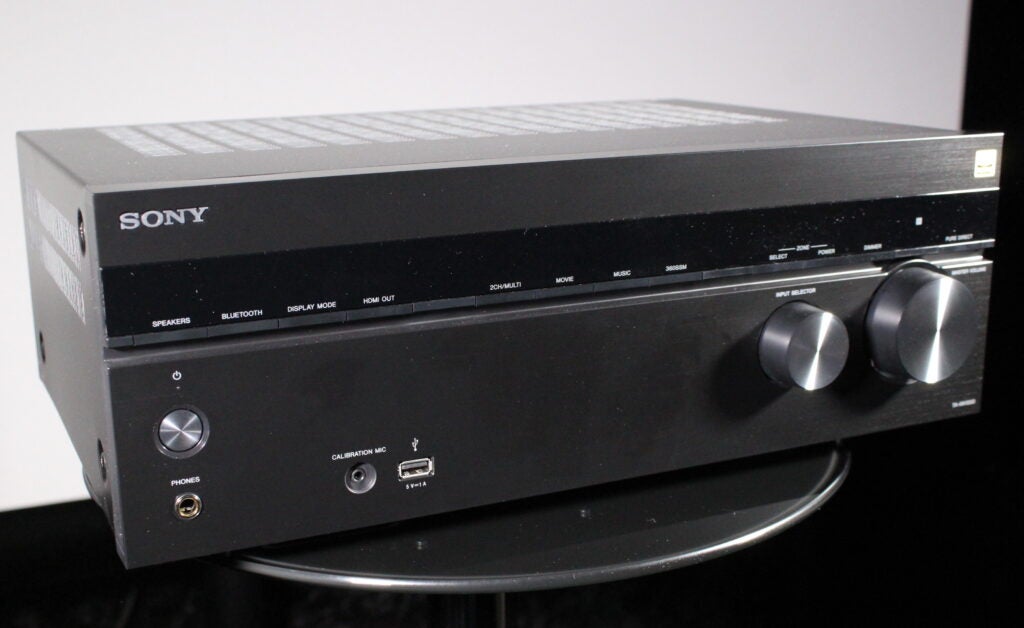
If you don’t fancy running speaker cables around your lounge or living room, the TA-AN1000 can connect wirelessly with optional speakers offered by Sony. These include the SA-RS3 and SA-RS5 rear speakers, and the SA-SW3 and SA-SW5 subwoofers. While this approach is convenient, it will significantly add to the cost of building a system, especially compared to a passive speaker package.
In terms of other features the TA-AN1000 supports high-resolution audio, plus there’s Sony’s Acoustic Centre Sync, which allows owners of the brand’s compatible Bravia TVs to use their set’s speakers as the centre channel in a multichannel system. There is a dedicated S-Centre Out jack at the rear of the amp for this specific purpose.
One final observation, in the UK and Europe the TA-AN1000 has no AM/FM tuner, which is why it’s described as an AV amplifier, but in the US and Australia the model number is STR-AN1000, and this version does include a tuner, thus making it an AVR receiver.
Performance
- Full-bodied and engaging delivery
- Well-rounded bass response
- Excellent placement of effects
The Sony TA-AN1000 is pleasingly simple to setup, in part because it’s limited to only 7.1 channels, but also because it has an informative user interface that produces an onscreen menu system with everything you need for installation and operation presented in a layout that’s easy to access and understand.
The automatic calibration is very effective, only requiring you to attach the provided microphone to the included stand, connect it to the dedicated jack at the front, and follow the instructions. Measurements are combined with acoustic filters to smooth out bass response and eliminate the more egregious sonic characteristics of your room.
Once up and running, I’m immediately impressed by the capable and engaging performance. There’s a full-bodied quality to the overall delivery, retaining clear dialogue, well-defined sound effects, and bass that remains both smooth and impactful. There’s a composure to the soundstage that proves the room calibration has been effective in balancing everything out.

When it comes to two-channel audio the Sony is good but lacks some of the refinement and deftness of touch that I’d associate with the very best AV amplifiers and receivers in this price bracket. This is a shame because the TA-AN1000 includes extensive music and high-resolution audio support, and the built-in amplification certainly has sufficient grunt to drive even a demanding pair of floorstanders without breaking a sweat.
However, the onboard juice does start to run out once I move on to multichannel audio, and even with a 5.1 mix there’s a feeling of strain as I crank up the volume. In smaller rooms the TA-AN1000 will be fine, but larger spaces may prove challenging, especially if you enjoy listening at unsociable levels. This issue is only compounded when running all seven channels simultaneously, so a degree of expectation management is required.
This is particularly true when dealing with Dolby Atmos and DTS:X object-based audio soundtracks in a 5.1.2-channel configuration, where all seven channels are often being used at the same time to create an immersive acoustic hemisphere. However, as long as you’re listening at sensible levels the placement and steering of sound effects around the room is excellent, with seamless transitions and a greater sense of three dimensionality.
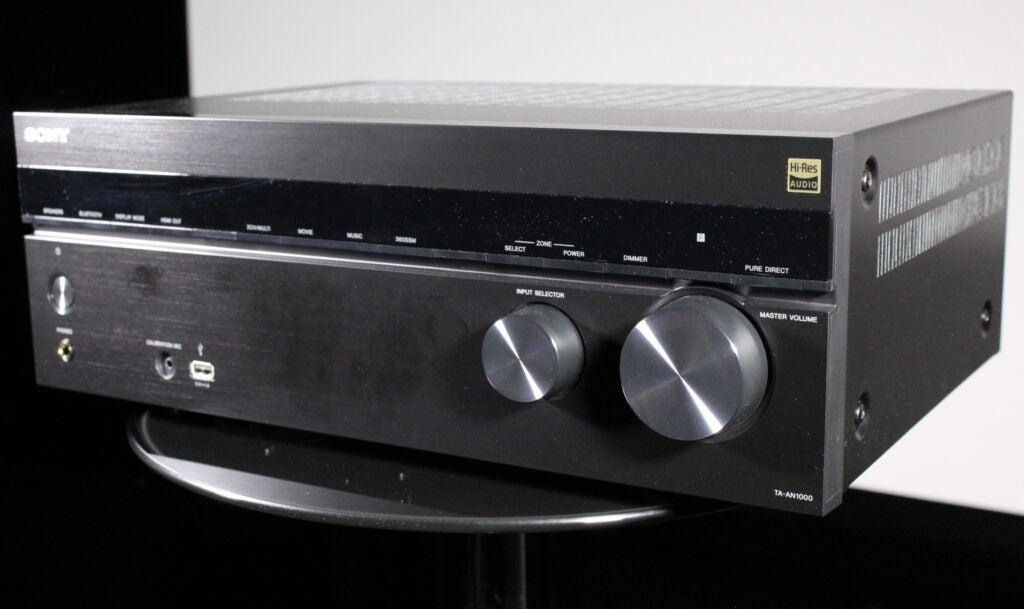
If you’re listening to Dolby Atmos or DTS:X natively, the 5.1.2-channel system is generally effective, and more than enough for most people. A dynamic mix like Midway will make use every available channel to create a visceral sonic experience as it places you right in the middle of the action, but the limitations of a 5.1.2-channel layout can become apparent, especially as objects move behind you and disappear into a sonic hole where there aren’t any speakers.
Thankfully Sony’s 360 Spatial Sound Mapping can prove a powerful tool when it comes to producing a better immersive experience despite the TA-AN1000’s inherent channel limitations. Applying this added processing helps create a more seamless bubble of sound that surrounds and envelops you, and is genuinely impressive when it comes to generating the sensation of there being more speakers around you than are physically present in reality.
While I found the 360 Spatial Sound Mapping most rewarding with immersive audio soundtracks, it can also be applied to two-channel and multichannel mixes, creating a more expansive delivery with greater width and added height. It can be a bit hit and miss with some effects sounding unnatural, especially dialogue, but the sense of immersion is readily apparent. I’m more of a purist, so I’d leave non-immersive mixes alone, but with object-based audio soundtracks like Dolby Atmos and DTS:X the benefits of those extra virtual speaker is undeniable.
Latest deals
Should you buy it?
You don’t want to compromise on speaker placement
The TA-AN1000’s inclusion of Sony’s 360 Spatial Sound Mapping allows you to produce a more immersive object-based audio experience thanks to the combination of measurements and clever psychoacoustic processing that creates virtual speakers where you can’t position real ones. This sonic wizardry also helps compensate for this AV amplifier’s limited channel count.
You want a big and powerful multichannel delivery
The seven channels of built-in Class D grunt are sufficient for medium-sized rooms, but if you have a larger space you’ll need a more powerful AV amplifier or receiver. The TA-AN1000 also struggles a bit when driving all seven of its channels simultaneously, so you can’t escape the feeling the amp is beginning to run out of steam and sounds a little strained.
Final Thoughts
The Sony TA-AN1000 is a capable and well-specified AV amplifier that delivers an enjoyable multichannel experience. The seven built-in channels of power and 7.1-channel processing allow it to decode and deliver object-based audio with an undeniable sense of fun, and whether it’s Dolby Atmos, DTS:X or IMAX Enhanced, the placement and steering of sound effects is precise and seamless, while the low-end retains plenty of LFE heft.
The addition of 360 Spatial Sound Mapping is definitely a benefit, using proprietary processing to create virtual speakers where you can’t install real ones, and allowing the TA-AN1000 to overcome the limitations of its 7.1-channel processing. The inclusion of various gaming enhancements will also prove popular, as will high-resolution audio support, extensive networking features, and voice control thanks to Google Home.
However the build quality feels lightweight, the remote is disappointing and the rear connections rather limited. The built-in amplification also struggles when driving all seven channels simultaneously, and there’s a lack of musicality and refinement when compared to competitors like the Denon AVC-X3800H, Marantz Cinema 60, and Yamaha RX-A4A. This is a crowded segment of the market, and the Sony TA-AN1000 doesn’t quite measure up to the very best.
How we test
We test every set of AV amplifier we review thoroughly over an extended period of time. We use industry standard tests to compare features properly. We’ll always tell you what we find. We never, ever, accept money to review a product.
Find out more about how we test in our ethics policy.
Tested for more than a week
Tested with real world use
FAQs
In the UK and Europe the TA-AN1000 has no AM/FM tuner, while the US and Australia the model number is STR-AN1000 as this version does include a tuner.


